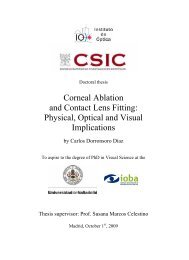Aberrations and visual performance following standard laser vision ...
Aberrations and visual performance following standard laser vision ...
Aberrations and visual performance following standard laser vision ...
Create successful ePaper yourself
Turn your PDF publications into a flip-book with our unique Google optimized e-Paper software.
<strong>Aberrations</strong> <strong>and</strong> Visual Performance Following St<strong>and</strong>ard Laser Vision Correction/MarcosABCVA = 1BCVA = 0.9BCVA = 1BFigure 5. A) Modulation transferratio postoperative/preoperative(solid line) <strong>and</strong> contrast sensitivityratio postoperative/preoperative(circles <strong>and</strong> dashed line) as afunction of spatial frequency. Dataare average of 22 eyes. Pupildiameter = 3 mm for the modulationtransfer function (MTF), <strong>and</strong>undilated for the contrast sensitivityfunction (CSF). B) Simulation ofretinal image quality (obtained byconvolution of the 20/20 line on aSnellen chart <strong>and</strong> the correspondingpoint spread function) <strong>and</strong> clinicalmeasurements of best spectacle-corrected<strong>visual</strong> acuity, forthree eyes (#14, #21, #11) withdifferent surgical outcomes.between 3 <strong>and</strong> 18 c/deg. The area under the MTF(average of 22 eyes) decreased by a factor of 1.38after LASIK, <strong>and</strong> the area under the contrastsensitivity function (average of 22 eyes) decreasedby a factor of 1.51 after LASIK. This indicates thatthe average image contrast degradation estimatedfrom wave aberration data accounts for most of thedecrease in contrast sensitivity in this spatial frequencyrange. Figure 5 shows the average contrastratio before <strong>and</strong> after surgery for both modulationtransfer <strong>and</strong> contrast sensitivity as a function ofspatial frequency. Again, both functions tend todecrease similarly with LASIK. The fact that contrastsensitivity function seems to suffer a slightlylarger degradation could be due to the fact thatpupils were larger than 3 mm during the contrastsensitivity function measurements, that the <strong>visual</strong><strong>performance</strong> <strong>and</strong> aberration measurements werenot collected on the same day, that MTF computationswere based on monochromatic aberrationswhereas contrast sensitivity function was measuredin polychromatic light, or that other factors apartfrom the aberrations (such as haze) may also contributeto contrast degradation. The eye in whichthe root mean square decreased (although not significantly)after LASIK experienced a slightincrease in the MTF postoperative/preoperativeratio, as well as a contrast sensitivity improvementat certain spatial frequencies (3 <strong>and</strong> 12 c/deg).We also compared <strong>visual</strong> <strong>performance</strong> (best spectacle-corrected<strong>visual</strong> acuity [BSCVA]) with simulationsof retinal images of a Snellen chart. Thesewere generated by convolution of point-spread-functions(computed from the wave aberrations) withimages of the Snellen chart. These simulations donot represent <strong>vision</strong> of patients, but provide an ideaof the image quality on the retinal plane. Figure 5Bshows simulations of the 20/20 line of a Snellenchart for three eyes (#14, #21, #11) after LASIK.Clinical BSCVA measurements for these eyes arereported. In many cases, such as eye #14, a cleardegradation of retinal image quality is not associatedwith a line loss, indicating that unlike contrastsensitivity, high-contrast <strong>visual</strong> acuity is not a verysensitive measurement to evaluate the changesinduced by refractive surgery.From measurements of total <strong>and</strong> corneal aberrations,contrast sensitivity <strong>and</strong> <strong>visual</strong> acuity measuredin a group of eyes before <strong>and</strong> after surgery, weconclude that:1) Both total <strong>and</strong> corneal aberrations increasesignificantly <strong>following</strong> st<strong>and</strong>ard myopic LASIK.2) Total aberrations should be better correlated to<strong>visual</strong> <strong>performance</strong> than corneal aberrations alone.Although most of the changes occur on the anteriorcorneal surface, in general corneal aberrations arenot sufficient to underst<strong>and</strong> the changes induced byrefractive surgery. Preoperative interaction of thecorneal <strong>and</strong> internal optics, <strong>and</strong> possible changesinduced on the posterior corneal surface also contributeto the total aberration pattern.3) Most of the decrease in contrast sensitivity canbe accounted for by the decrease in the modulationtransfer function (computed from the total waveaberration)4) High contrast <strong>visual</strong> acuity is not a very sensitivemeasurement of image quality.REFERENCES1. Oshika T, Klyce SD, Applegate RA, Howl<strong>and</strong> HC, ElDanasoury MA. Comparison of corneal wavefront aberrationsafter photorefractive keratectomy <strong>and</strong> <strong>laser</strong> in situkeratomileusis. Am J Ophthalmol 1999;127:1-7.S600 Journal of Refractive Surgery Volume 17 September/October 2001











